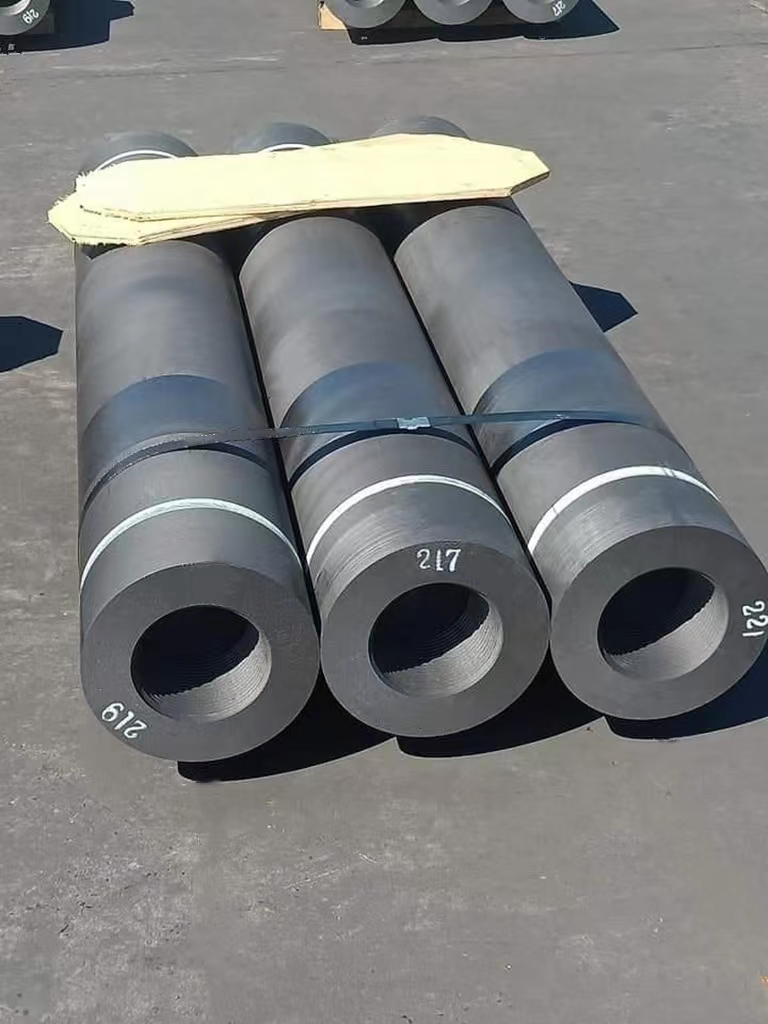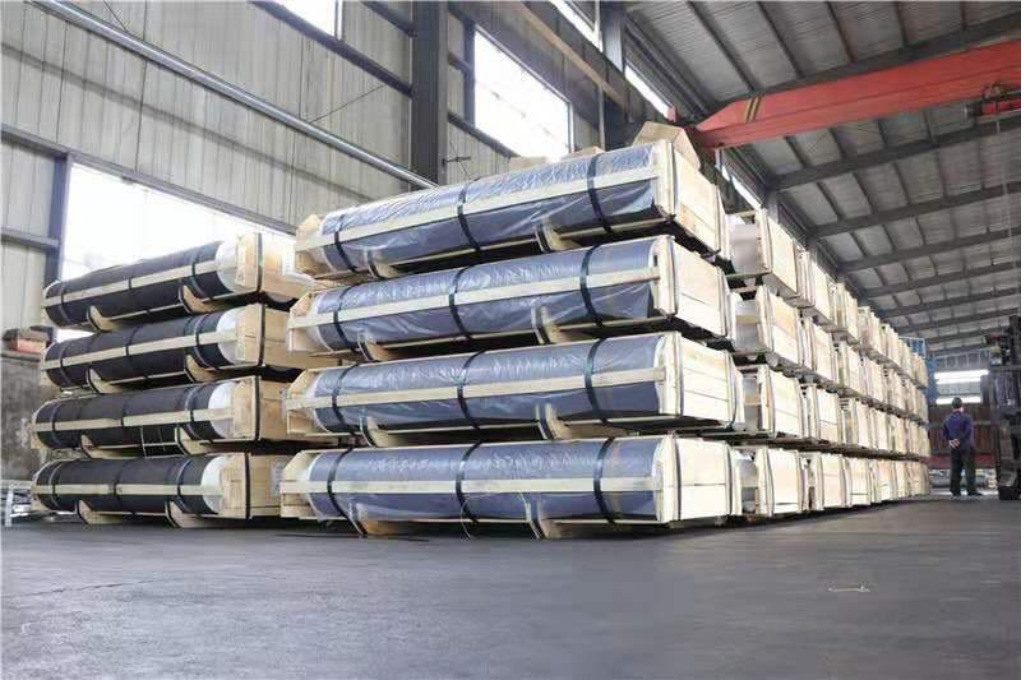The uses of graphite electrode is increasing due to the development of electric arc furnace steelmaking applications. Since the 20th century, the demand for special steel has risen sharply in industries such as automobiles, aircraft, machinery, and electrolysis. After the 1950s, electric arc furnace steelmaking developed towards large-scale and ultra-high power, which improved productivity, and developed a steelmaking method for smelting ordinary steel from scrap steel.
Table of Contents
ToggleIn recent years, steel mills have begun to use scrap steel to produce ordinary steel, further promoting electric arc furnace steelmaking with the successful development of the large DC electric furnace. Graphite electrodes serve as conductors in electric arc furnace steelmaking and play a supporting role in the process.
Graphite electrode used for eaf steelmaking
Graphite electrode is mainly used for eaf steelmaking production. They have a wide range of applications in the industry due to their electrical conductivity and high thermal and chemical stability, such as refining steel, smelting metals, and producing non-ferrous alloys.
Their high-temperature stability of it makes them suitable for various industrial processes. These graphite electrodes are used to create electric arcs in various metal melting applications. This includes melting steel and other metals, creating alloys, welding castings, and forging parts.
They can withstand strong current shocks and are not easily oxidized as current-carrying conductors. It can withstand extremely high temperatures of 3600 degrees Celsius. Currently, no material can replace graphite electrodes in the smelting process.

Properties of Graphite Electrodes
- Density: Compared with other materials, the density of graphite electrodes is higher, between 1.6-1.78g/cm3.
- Conductivity: The particular layered structure of carbon atoms in graphite is conducive to the free flow of electrons, so the conductivity is solid.
- Flexural strength: Graphite has high mechanical strength, so the bending moment stress per unit area is relatively large.
- Modulus of elasticity: Young’s modulus increases with temperature.
- Thermal conductivity: Graphite is a non-metallic mineral, and its heat conduction method is the thermal vibration of lattice atoms to transfer heat.
- Thermal expansion coefficient: It is much lower than other materials and is more suitable for environments with high temperatures and significant changes.
- Corrosion resistance: Because of its stable chemical properties, it does not react with other substances at room temperature.
UHP graphite electrdoes
Graphite electrode used for DC electric arc furnace
The arc length per unit voltage of the DC electric arc furnace is more significant than that of the AC electric arc furnace, and the operating conditions of the graphite electrodes are more severe.
The industry requires electrodes with lower resistivity, thermal expansion coefficient, and higher bulk density for such high-current operation.
We can change the characteristics by adjusting the raw materials and production process types. You achieve control over these characteristics, which adapt to the operating conditions of the electric arc furnace.
Specific case studies and examples of successful use of graphite electrodes:
Steel Industry: They are widely used in Electric Arc Furnaces (EAF) for steel production. They serve as the conductive elements that create the electric arc to melt the scrap. Electrodes must withstand extreme temperatures and high mechanical stress. They have excellent thermal resistance and mechanical strength and are the preferred choice for this application.
Aluminum industry: Graphite electrodes are used in the smelting process of aluminum production. They are used in the electrolysis of aluminum oxide (aluminum oxide) in electrolytic cells. They act as the cathode, carrying the current to separate the aluminum from the alumina. Graphite’s high electrical conductivity and chemical stability suit this process.
Silicon Industry: They can produce silicon and other silicon-based materials. In silicon refining, quartz, coke, etc., are used as raw materials to obtain high-purity silicon through chemical reactions. They are used in a resistance furnace to provide the required heat for the response. They have excellent thermal stability and chemical resistance.
Foundry Industry: Graphite electrodes manufacture cast iron and steel products in foundries. In this process, they are used in electric arc furnaces to melt the metal and act as conductors when starting the casting process. Graphite’s high melting point and thermal conductivity facilitate efficient heat transfer and can improve the quality of castings.
Chemical Industry: They are used in various chemical processes that require high temperatures and electrical conductivity. For example, they are used in electrolyzers to produce chlorine gas and caustic soda from brine solutions. They are also used to create certain chemicals, such as graphite fluoride, through electrochemical reactions.
Changes in demand for graphite electrodes
More than 95% of artificial graphite electrodes are used for electrodes for electric arc furnace steelmaking. Therefore, the quality of electrodes is directly proportional to the output of electric arc furnace steelmaking. Benefit from high-quality electrodes with needle coke.
As far as the world is concerned, with the increase in electric arc furnace steelmaking and the decrease in electrode unit consumption, the demand for artificial graphite electrodes may remain unchanged or slightly increase.
In the future
Demand and Growth: The steel industry primarily drives the need for graphite electrodes, which will likely remain strong as global steel production grows. Moreover, emerging industries such as electric vehicles and renewable energy will probably drive further demand for them, especially for applications such as lithium-ion battery production.
Sustainability and Environmental Concerns: With increasing emphasis on sustainability and reducing carbon emissions, industries are exploring alternative processes and materials. While graphite electrodes contribute to energy-efficient and environmentally-friendly processes like electric arc furnaces, there is ongoing research to develop more sustainable and eco-friendly alternatives.
Technological Advancements: The development of new technologies and materials may impact the future of graphite electrodes. For instance, nanotechnology and carbon-based materials advancements could lead to novel electrode materials with enhanced performance and properties.
Shifts in Industrial Processes: The evolution of industrial processes, such as adopting new smelting technologies or alternative manufacturing methods, could influence the demand for them. It is essential to monitor industry trends and innovations to gauge their prospects.
In conclusion
While graphite electrode plays a significant role in various industries and applications, predicting their future requires considering multiple factors. The growth of industries that rely on graphite electrode, advancements in materials science, sustainability concerns, and emerging technologies will shape the future landscape. Monitoring industry trends and technological advances is crucial to determine their long-term prospects.



